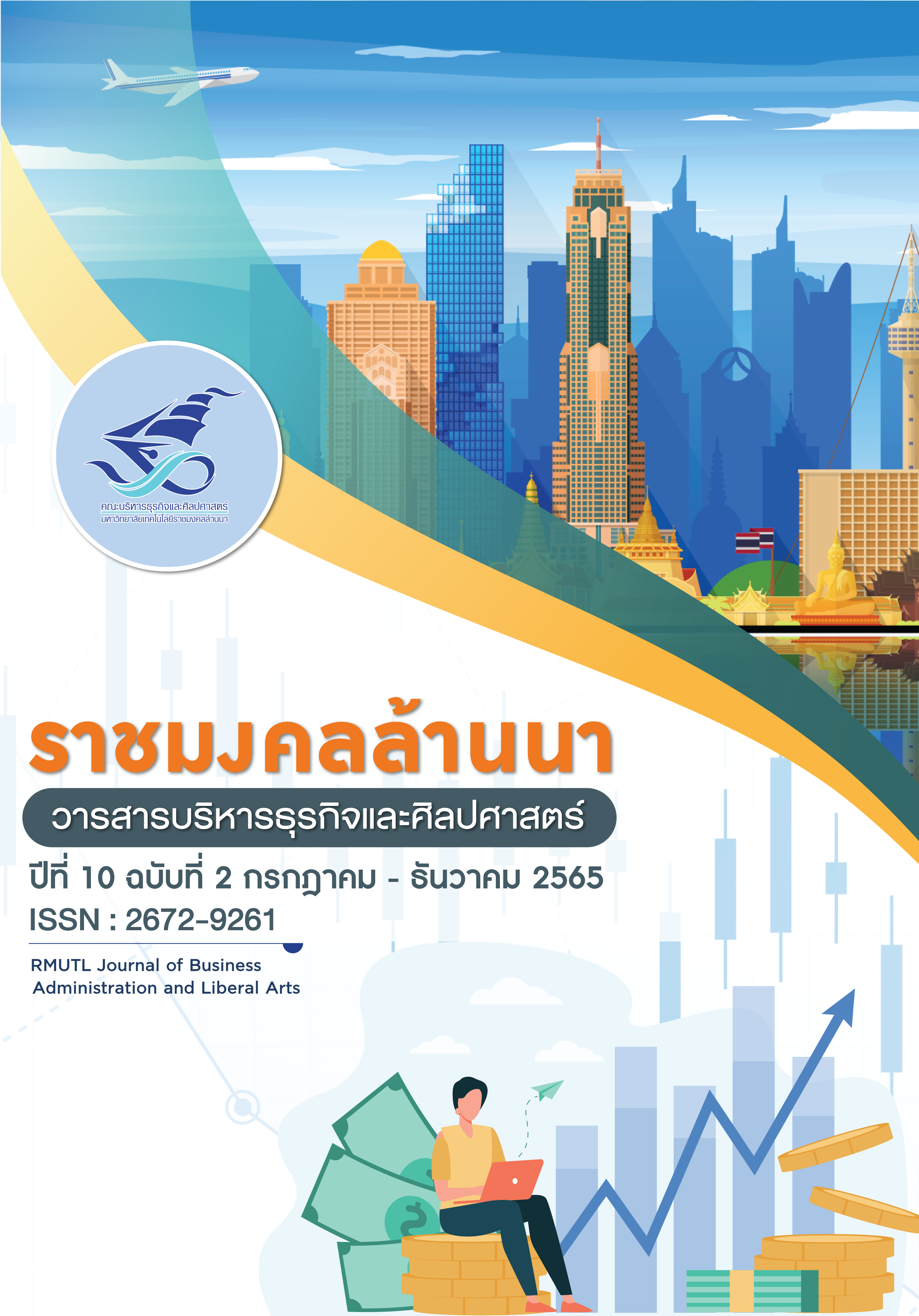Effect of Service Marketing Mix, Electronic Service Quality, Technology Acceptance toward Satisfaction in Ordering Food Delivery through the Application of Consumer in Lampang Province
Main Article Content
Abstract
The purpose of this research was to study the importance of the service marketing mix, e-service quality, technology acceptance, and satisfaction, and to study the effect of the service marketing mix, e-service quality, and technology acceptance toward satisfaction ordering food delivery through the consumer application in Muaeng Lampang District, Lampang Province. It is quantitative research. The sampling group was 384 consumers who have used the food delivery service through the application. The tool was a questionnaire. Data were used descriptive statistics to find percentages, averages, and standard deviation, inferential statistics were used multiple regression to analyze with Enter selection technique.
The outcomes of the research study revealed that all factors were at a high level, of e-service quality, followed by technology acceptance and service marketing mix in equal proportions and the last satisfaction.
The outcomes of multiple regression analysis were that the e-service quality had direct effect toward satisfaction, and followed by technology acceptance had direct effect toward satisfaction, and service marketing mix had direct effect toward satisfaction, by all factors were significant at 0.05. Thus, this research has resulted in online business operators to develop and improve their services for planning and formulate marketing strategies to consumer needs and drive the online business to be able to compete continuously.
Article Details

This work is licensed under a Creative Commons Attribution-NonCommercial-NoDerivatives 4.0 International License.
บทความวิจัยนี้เป็นของลิขสิทธิ์
References
การเงินการธนาคาร. (2564). Food deliveryเดินหน้าขยายตลาดพร้อมบริการที่หลากหลาย. สืบค้น 30 พฤษภาคม 2565, จาก https://www.moneyandbanking. co.th/article/news/food-delivery-sevice-new-normal-031164
ณัฐพงค์ รัตนะพรม, ชีวพัฒน์ อาจการ, ศิริลักษณ์ เพียรการ, อัจฉรา เมฆสุวรรณ, และขจรศักดิ์ วงศ์วิราช. (2562). ปัจจัยส่วนประสมทางการตลาด และความน่าเชื่อถือของเว็ปไซต์ที่มีผลต่อการตัดสินใจเลือกซื้อสินค้าผ่านอินเทอร์เน็ต อำเภอเมือง จังหวัดลำปาง. วารสารมหาวิทยาลัยราชภัฏลำปาง, 8(1), 17-29.
บุณยานุช เปี้ยยา, อัจฉราพร แปลงมาลย์, และสรวิทย์ ปานพินิจ. (2565). พฤติกรรมการสั่งซื้ออาหารและทัศนคติที่มีต่อส่วนประสมการตลาด ที่ส่งผลต่อการสั่งซื้ออาหารโดยใช้แอปพลิเคชันของผู้บริโภค อำเภอเมือง จังหวัดลำปาง. วารสารวิชาการเทคโนโลยีการจัดการ, 3(1), 24-39.
บูรณ์เมตต์ วิวัฒนานุกูล. (2564). ทำความรู้จักธุรกิจ B2C e-Commerce: รูปแบบธุรกิจ รูปแบบการชำระเงิน และวิธีการติดตามภาวะตลาด. สืบค้น 30 พฤษภาคม 2565, จาก https://www.bot.or.th/Thai/Statistics /Articles/pages/horizonpage.aspx
พัชร์หทัย จารุทวีผลนุกุล ปิยากร พรพีวิชญ์ เปมิกา พันธุ์สุมา และพิจักษณ์ วราเสนีย์วุฒิ. (2563). ปัจจัยที่ส่งผลต่อความพึงพอใจของผู้บริโภคในการใช้บริการแอปพลิเคชันของฟู้ดแพนด้าในเขตกรุงเทพมหานครและปริมณฑล. วารสารเครือข่ายส่งเสริมการวิจัยทางมนุษยศาสตร์และสังคมศาสตร์, 3(2), 29-42.
เพ็ญวิภา เพชร์จั่น และกาญจนา มีศิลปวิกกัย. (2562). ปัจจัยส่วนประสมทางการตลาดและการตัดสินใจสั่งซื้ออาหารที่ส่งผลต่อความพึงพอใจของการใช้งานแอปพลิเคชันไลน์แมนในเขตกรุงเทพมหานคร. วารสารนิเทศสยามปริทัศน์, 18(2), 183-190.
ภานุพงศ์ ลือฤทธิ์. (2560). คุณภาพการบริการอิเล็กทรอนิกส์ในการสร้างความพึงพอใจของผู้ใช้งาน: กรณีตัวอย่างของแอปพลิเคชันกระเป๋าเงินบนโทรศัพท์มือถือ.(การค้นคว้าอิสระปริญญามหาบัณฑิต). กรุงเทพฯ: มหาวิทยาลัยธรรมศาสตร์.
วุฒิกร บุญลือ และพัชร์หทัย จารุทวีผลนุกูล. (2562). การยอมรับเทคโนโลยีและส่วนประสมทางการตลาดที่ส่งผลต่อความพึงพอใจในการใช้แอปพลิเคชันซื้อขายเกษตรอินทรีย์ของกลุ่มลูกค้าในประเทศไทย. วารสารวิชาการ การตลาดและการจัดการมหาวิทยาลัยเทคโนโลยีราชมงคลธัญบุรี, 6 (2), 1-13.
ศิริวรรณ เสรีรัตน์ ปริญ ลักษิตานนท์ และศุภร เสรีรัตน์. (2546). การบริหารการตลาดยุคใหม่. กรุงเทพฯ: ธรรมสาร.
ศูนย์วิจัยกสิกรไทย. (2564). Food Delivery ปี 2565 ขยายตัวต่อเนื่อง ผู้ให้บริการแอพพลิเคชั่นรุกพื้นที่ต่างจังหวัดขยายฐานลูกค้าใหม่. สืบค้น 30 พฤษภาคม 2565, จากhttps://www.kasikornresearch. com/th/analysis/k-econ/business/Pages /Food-Delivery-z3289.aspx
สารัช สุธาทิพย์กุล. (2560). สภาพปัญหา และการเรียนรู้การใช้เทคโนโลยีของผู้สูงอายุ กรณีศึกษา ผู้สูงอายุที่ใช้สมาร์ทโฟน ในพื้นที่บริเวณโดยรอบพระปิ่นเกล้า เขตบางกอกน้อย จังหวัดกรุงเทพมหานคร. สืบค้น 30 พฤษภาคม 2565, จาก https://repository.rmutr.ac.th/bitstream/handle/123456789/760/rmutrconth_114.pdf?sequence=1&isAllowed=y
สำนักงานพัฒนาธุรกรรมทางอิเล็กทรอนิกส์. (2563). e-Commerce. สืบค้น 30 มิถุนายน 2564, จาก https://www. etda.or.th
สำนักงานพัฒนาธุรกรรมทางอิเล็กทรอนิกส์ (2564). ผลสำรวจพฤติกรรมผู้ใช้อินเทอร์เน็ตในประเทศไทย ปี 2564. สืบค้น 30 พฤษภาคม 2565, จาก (THAILAND INTERNET USER BEHAVIOR 2021). https://www.etda.or.th/th /Useful-Resource/publications /Thailand-Internet-User-Behavior-2021_Slides.aspx
สิรินยา ใจละออ, เบญจพร ปวนคำ, พิยดา ผุยชาคำ, และขจรศักดิ์ วงศวิราช. (2564). แรงจูงใจในการเข้าสู่ตลาดออนไลน์ของผู้ประกอบการในจังหวัดลำปาง ผ่านแอปพลิเคชันฟู้ดแพนด้า. วารสารศิลปการจัดการ, 5(1), 30-44.
อนาวิล ศักดิ์สูง, อัศนีย์ ณ น่าน, และ ฑัตษกร ศรีสุข. (2563). การยอบรับเทคโนโลยีโทรศัพท์มือถือและพฤติกรรมผู้บริโภคออนไลน์ที่ส่งผลต่อการเลือกใช้บริการสั่งอาหารผ่านแอปพลิเคชันของผู้บริโภคในจังหวัดลำปาง. วารสารวิจัยมหาวิทยาลัยเวสเทิร์น มนุษยศาสตร์และสังคมศาสตร์, 6(3), 162-174.
อริญญา เถลิงศรี. (2563). 4 ทักษะที่นักการตลาดต้องมี เพื่อรับมือ New Normal ของโลกการตลาดยุคหลัง Covid-19. สืบค้น 30พฤษภาคม 2565, จาก https://www.brandbuffet.in.th/2020/04/covid-19-changebehavior-new-normal.
อัศนีย์ ณ น่าน, ณัฐนันท์ ทองทรัพย์, และพรเพ็ญ เพ็ชรสุขศิริ. (2564). ความสัมพันธ์ระหว่างการสื่อสารแบบปากต่อปากทางอิเล็กทรอนิกส์ (e-WOM) และพฤติกรรมในการเลือกใช้บริการสั่งอาหารผ่านแอปพลิเคชันของผู้บริโภคในจังหวัดลำปาง. วารสารวิจัยมหาวิทยาลัยเวสเทิร์น มนุษยศาสตร์และสังคมศาสตร์, 7(1), 263-273.
Camarero, C., Antón, C., & Rodríguez, J. (2013). Technological and ethical actecedents of e-book piracy and price acceptance. Journal of the Electronic Library, 32(4), 542–566.
Cochran, W.G. (1977). Sampling Techniques. (3d ed.) New York: John Wiley and Sons Inc.
Cronbach, L. J. (1974). Essential of Psychological Testing. New York: Harper & Row.
Cotirlea, D. (2011). Issues regarding e-service quality management: Customization on online Tourism Domain. Polish Journal of Management Studies, 3, 32-43.
Davis, F. (1989). Perceived Usefulness, Perceived Ease of Use, and User Acceptance of Information Technology. MIS Quarterly, 13, 319-340.
Etzel, M. J., Walker, B. J., & Stanton, W. J. (2007). Marketing (14th ed.). Boston: McGraw-Hill/ Irwin.
Likert, R. N. (1970). A technique for the measurement of attitude. Attitude Measurement. Chicago: Ronal McNally & Company.
Hill, N., & Alexander, J. (2006). Handbook of customer satisfaction and loyalty measurement (Third edition). New York: Gower Publishing.
Kotler, Philip., & Keller, Kevin Lane. (2016). Marketing Management. (15th ed.). New York: Pearson Education.
Kusdibyo, L., & Februadi, A. (2019). The effect of electronic service quality on customers satisfaction and loyalty in online shopping. In IOP Conference Series: Materials Science and Engineering, 662(2). 22036.
Nattapong Techarattanased. (2019). Service marketing mix and acceptance of technology affecting consumers’ satisfaction through food delivery applications. International conference on Management Science, Innovation and Technology, 155-162.
Nguyen, T., Ninh, N., Nguyen, B., Plan, & Moon, H. (2019). Investigating consumer attitude and intention towards online food purchasing in an emerging economy: An extended TAM approach. Foods, 8(576), 1-1.
Lovelock, C., & Wirtz, j. (2011). Pricnciples of Service Marketing: People, Technology, Strategy (7th ed.). The United States of America: Pearson Education.
McCarthy, E. J. (1971). Basic Marketing: A Managerial Approach (4th ed.). Homewood, IL: Irwin.
Millet, J.D. (2012). Management in the Publics Service: The Quest for Effective Performance. New York: Mcgraw-Hill Book Compan.
Oliver, R. L. (1980). A cognitive model of the antecedents and consequences of satisfaction decisions. Journal of Marketing, 17(4), 460-469.
Parasuraman, A., Zeithaml, V. and Berry, L.L. (1985). A conceptual model of service quality and its implications for future research. Journal of Marketing, 49(4), 41–51.

